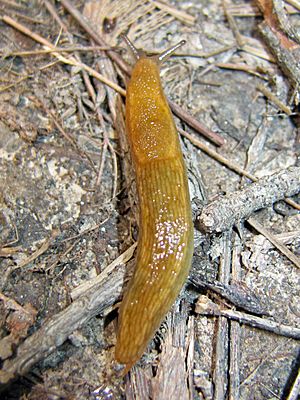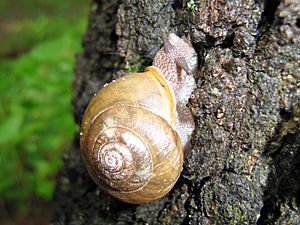List of non-marine molluscs of the Indiana Dunes facts for kids
This article is about the amazing world of non-marine mollusks found in the Indiana Dunes National Park. This park is a special place located right on the shore of Lake Michigan in Indiana, USA. Non-marine mollusks are creatures like snails, slugs, and freshwater bivalves (which are like clams and mussels).
In May 2009, scientists and volunteers held a special event called a BioBlitz at the Indiana Dunes. During this event, they worked hard to find and list all the different kinds of living things in the park. They discovered a total of 66 different species of mollusks! This included 46 types of snails and slugs, and 20 types of freshwater clams and mussels. It shows just how much life can be found in one park!
Contents
Meet the Gastropods: Snails and Slugs
Gastropods are a large group of mollusks that include all snails and slugs. They are known for having a single, muscular "foot" that they use to crawl around. Many gastropods have a shell, like snails, but some, like slugs, do not.
Freshwater Snails: Tiny Explorers of Water
Freshwater snails live in lakes, rivers, and ponds. They play an important role in these watery environments. Some breathe with gills, just like fish, while others can breathe air. Here are some of the freshwater snails found at the Indiana Dunes:
- Amnicola limosus – a very small snail with a gill
- Aplexa hypnorum – a small, air-breathing snail that coils to the left
- Campeloma decisum – also called the pointed campeloma
- Gyraulus parvus – a tiny rams horn snail
- Helisoma anceps – a two-ridge rams horn snail
- Menetus dilatatus – another small rams horn snail
- Physella gyrina – an air-breathing snail that coils to the left
- Planorbella campanulata – a bell-shaped rams horn snail
- Planorbella trivolvus – a small aquatic snail
- Planorbula armigera – a rams horn snail with tiny "teeth" inside its shell
- Pleurocera acuta – a hornsnail with a tall, pointed shell
- Pomatiopsis lapidaria – a snail that lives near water but can also be found on land
- Promenetus exacuous – a small rams horn snail with a very flat shell
- Stagnicola caperatus – an air-breathing pond snail
- Stagnicola elodes – another air-breathing pond snail
- Valvata perdepressa – a freshwater snail with a gill, also called a valve snail
Land Snails and Slugs: Garden Guests and Forest Dwellers
Land snails and slugs live on land, often in damp places like under logs, leaves, or rocks. Snails carry their shells on their backs, while slugs do not have a visible shell. Some slugs can be pests to gardens, but most are important parts of the ecosystem, helping to break down dead plants. Here are some of the land snails and slugs found at the Indiana Dunes:
- Anguispira alternata – known as the flamed tigersnail because of its striped shell
- Arion sp. – a type of land slug
- Arion subfuscus – a brownish-orange land slug
- Catinella vermeta – a small, amber-colored land snail
- Cochlicopa lubrica – a glossy pillar snail with a smooth, shiny shell
- Deroceras laeve – a marsh slug, often considered a pest in agriculture
- Euchemotrema sp. – a type of small snail with a hairy shell
- Euchemotrema froeteruum – a specific species of hairy snail
- Fossaria obrussa (also known as Lymaea obrussa) – a small pond snail that can also live on land
- Gastrocopta armifera – an armed snaggletooth snail, very tiny
- Gastrocopta contracta – a micromollusk (super tiny snail)
- Gastrocopta similis – another micromollusk
- Glyphyalinia indentata – a micromollusk with a clear, indented shell
- Haplotrema concavum – a snail that eats other snails
- Helicodiscus parallelus – a compound coil snail with a flat, coiled shell
- Hoyia sheldoni – a very small snail from the Hydrobiidae family
- Ariophanta laevipes (also known as Laevapex fuscus) – a limpet-like snail
- Limax maximus – the great gray slug, one of the largest slugs
- Mesodon thyroides (=? Mesodon thyroidus) – a large, hairy snail
- Nesovitrea electrina – a shiny, amber-colored land snail
- Novisuccinea ovalis – an ambersnail, often found near water
- Oxyloma sp. – another type of ambersnail
- Pallifera fosteri – the foster mantle slug, a native slug
- Philomycus carolinianus – a terrestrial land slug, also known as the Carolina mantleslug
- Pupoides albilabris – a minute land snail with a white lip on its shell
- Strobilops aeneus – a minute land snail with a ribbed shell
- Vallonia excentrica – a minute land snail common in Europe, but also found here
- Vertigo sp. – a type of minute land snail, often found in moss
- Zonitoides arboreus – a land snail found in many parts of the world, including greenhouses
- Zonitoides nitidus – a small, shiny land snail, mostly found in Europe but also elsewhere
Bivalves: Clams and Mussels of the Water
Bivalves are another group of mollusks that have two hinged shells, like a clam or a mussel. They live in water and filter their food from the water around them. They are very important for keeping water clean! Here are some of the freshwater bivalves found at the Indiana Dunes:
- Amblema plicata – the threeridge, a freshwater mussel with three ridges on its shell
- Anodontoides sp. – a type of freshwater mussel
- Corbicula fluminea – the Asian clam, an introduced species that can sometimes cause problems
- Dreissena polymorpha – the zebra mussel, an invasive introduced species that attaches to surfaces
- Elliptio dilatata – the spike mussel or lady finger, known for its long, narrow shell
- Fusconaia flava – a freshwater mussel with a yellowish shell
- Lampsilis cardium – a freshwater mussel, also called the plain pocketbook
- Lasmigona complanata – the white heelsplitter, a large mussel
- Lasmigona compressa – the creek heelsplitter, found in smaller streams
- Lasmigona costata – another type of heelsplitter mussel
- Musculium sp. – a type of freshwater clam, also called a globular pea clam
- Pisidium sp. – a pea clam, very small and round
- Pleurobema sintoxia – the round pigtoe, a mussel with a rounded shape
- Quadrula pustulosa – the pimpleback, a mussel with bumps on its shell
- Quadrula quadrula – the mapleleaf, a mussel shaped like a maple leaf
- Sphaerium occidentale – a fingernail clam, very small
- Sphaerium simile – another type of fingernail clam
- Strophitus undulatus – a freshwater mussel, also called the squawfoot
- Venustaconcha ellipsiformis – the ellipse, a mussel with an oval shape
- Villosa iris – the rainbow mussel, known for its colorful inner shell



